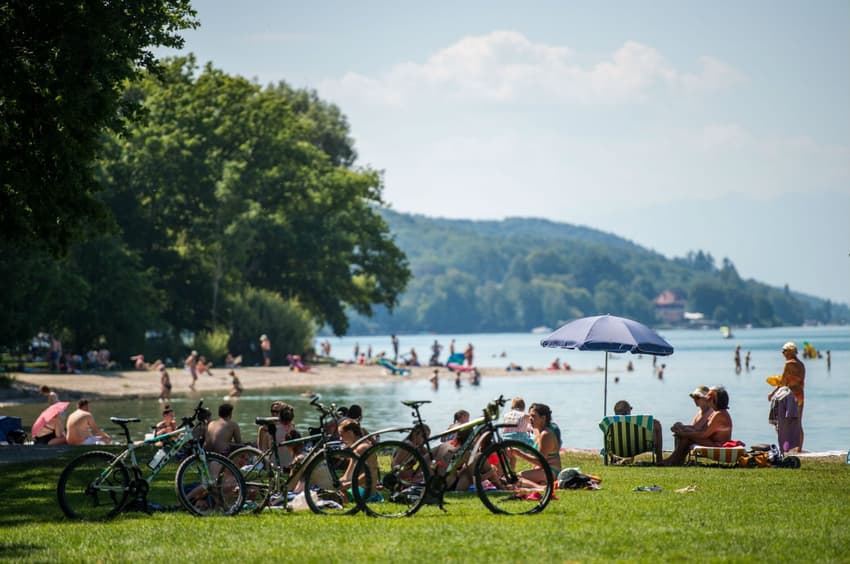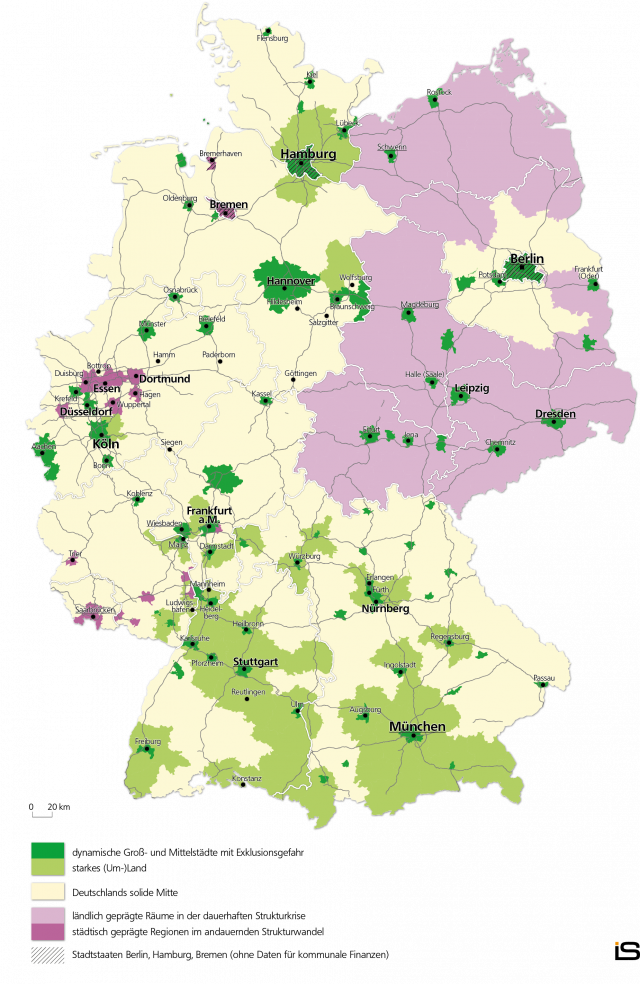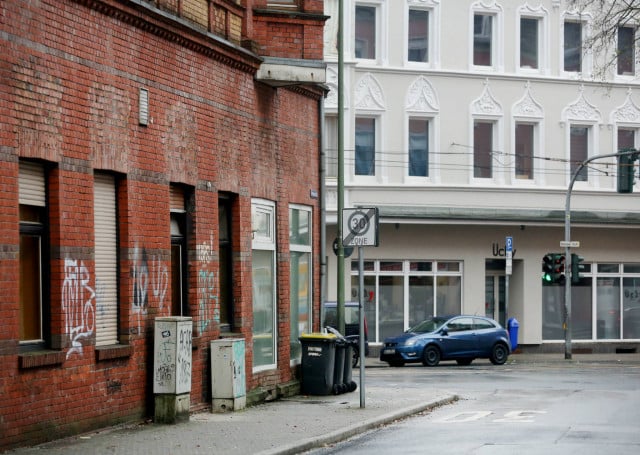Where Germans are living the good life… and where things aren’t so rosy

This study highlights just how stark the inequalities are across Germany's regions.
Seen from the outside, Germany is a country of prosperous and well-educated people. Certainly in comparison with its European neighbours, Germany has weathered the economic storms of the past decade without sustaining much damage.
But a closer look reveals a country of stark contrasts. That is the finding of a an in-depth study published earlier this year by the Friedrich Ebert Stiftung, a left-wing research centre funded by the Social Democrats.
READ ALSO:
The researchers looked at several indicators to try and pick apart where Germans are living the good life and where they live in relative deprivation. Under the microscope were traditional indicators of wellbeing, such as life expectancy and likelihood to vote, as well as more modern needs like broadband internet connection.
Their conclusion was that five different Germanys exist next to one another. As time goes by these five Germanys are becoming every more distinct, with possibly harmful effects for social cohesion, they argue.

This map breaks up the map into the 'five Germany's': Dark green is the booming cities, light green is the Speckgurtel, cream is the solid middle, pink is rural east Germany, and purple is the deprived cities.
The good life
The first Germany exists in the big cities where life is is buzzing, with 100 new inhabitants being added per 100,000 people every year. These sprawling metropoles, which include Berlin, Hamburg and Munich, are teeming with well-educated people earning high salaries. They enjoy good access to health care and have lightning-fast internet at their fingertips.
About quarter of the total population lives in these cities. Of course, these areas have their dark side. Child poverty is unusually high. And the highly educated are pushing up house prices… and thus pushing tradesmen, carers and other members of the working class out.
SEE ALSO: High costs, long queues and discrimination - what it's like to rent in Germany
The Speckgurtel (commuter belt, literally fat belt) is the second Germany. Life here is even better than in the big cities. People live to an average age of 82 and over 80 percent turn out to vote at elections, on both counts the highest levels in the country. This category includes scenic locations like Starnberg to the south of Munich or the Taunus near Frankfurt.
Local government in the Speckgurtel is also close to debt free, meaning they can provide people with excellent infrastructure. No wonder that every year these regions are expanding at the breathtaking rate of 200 people per 100,000 inhabitants. Commuting is for those who can afford it though, only 13 million Germans live in these exclusive and often beautiful areas.
The third, and largest, Germany is what the researchers call the solid middle. A total of 33 million people live in this category, which basically accounts for all the rural and small town regions of west Germany except for the wealthy south. Typical examples of the solid middle are the Sauerland in North Rhine Westphalia and rural Schleswig-Holstein.
People in these regions are relatively healthy, have good access to doctors and internet and are unlikely to be living in poverty. Nothing about their lives is exceptional, but it’s all pretty solid. This is illustrated by the stability of the population figures, which haven't changed significantly in years.
The flip side
The fourth Germany is in the rural areas of the east. Typical for this fourth Germany are villages on the Baltic coast or small towns in Saxony.
Wages here are dreadful in comparison to the rest of the country (on average just €2,460 per month), less than two thirds of locals have access to high speed internet and just one in ten have been to university. The undesirability of these areas is clearly illustrated by the fact that they are losing over 200 residents per 100,000 people every year.
The fifth and final Germany exists in the cities near the Dutch and French borders that never recovered from de-industrialization. Dortmund, Duisburg, Trier and other cities that used to profit from coal mining are still stuck in crisis decades after the mines were closed. They are heavily in debt, their populations are much more likely to be living in poverty than anywhere else in the country, life expectancy is a national low, as is election turnout.
These deprived cities are losing inhabitants at a rate even higher than rural east Germany. The only glimmer of hope is excellent internet coverage which could set them up to compete in the digital economy of the future.

Gelsenkirchen, a deprived city in the far west of the country. Photo: DPA
The Friedrich Ebert Stiftung argued that the government needed to step in to prevent the inequalities growing further.
“The evaluations for this study make it clear that the driving forces of inequality do not regulate themselves, quite the opposite: the interactions between advantages and disadvantages harden over time,” they wrote.
Central to their recommendations is a call for Berlin to provide debt relief to poor regions of the country so that they have more wiggle room to invest in the type of infrastructure that will reverse population decline and improve quality of life.
SEE ALSO: Poverty rising in Germany's industrial Ruhr region
Comments
See Also
Seen from the outside, Germany is a country of prosperous and well-educated people. Certainly in comparison with its European neighbours, Germany has weathered the economic storms of the past decade without sustaining much damage.
But a closer look reveals a country of stark contrasts. That is the finding of a an in-depth study published earlier this year by the Friedrich Ebert Stiftung, a left-wing research centre funded by the Social Democrats.
READ ALSO:
The researchers looked at several indicators to try and pick apart where Germans are living the good life and where they live in relative deprivation. Under the microscope were traditional indicators of wellbeing, such as life expectancy and likelihood to vote, as well as more modern needs like broadband internet connection.
Their conclusion was that five different Germanys exist next to one another. As time goes by these five Germanys are becoming every more distinct, with possibly harmful effects for social cohesion, they argue.

This map breaks up the map into the 'five Germany's': Dark green is the booming cities, light green is the Speckgurtel, cream is the solid middle, pink is rural east Germany, and purple is the deprived cities.
The good life
The first Germany exists in the big cities where life is is buzzing, with 100 new inhabitants being added per 100,000 people every year. These sprawling metropoles, which include Berlin, Hamburg and Munich, are teeming with well-educated people earning high salaries. They enjoy good access to health care and have lightning-fast internet at their fingertips.
About quarter of the total population lives in these cities. Of course, these areas have their dark side. Child poverty is unusually high. And the highly educated are pushing up house prices… and thus pushing tradesmen, carers and other members of the working class out.
SEE ALSO: High costs, long queues and discrimination - what it's like to rent in Germany
The Speckgurtel (commuter belt, literally fat belt) is the second Germany. Life here is even better than in the big cities. People live to an average age of 82 and over 80 percent turn out to vote at elections, on both counts the highest levels in the country. This category includes scenic locations like Starnberg to the south of Munich or the Taunus near Frankfurt.
Local government in the Speckgurtel is also close to debt free, meaning they can provide people with excellent infrastructure. No wonder that every year these regions are expanding at the breathtaking rate of 200 people per 100,000 inhabitants. Commuting is for those who can afford it though, only 13 million Germans live in these exclusive and often beautiful areas.
The third, and largest, Germany is what the researchers call the solid middle. A total of 33 million people live in this category, which basically accounts for all the rural and small town regions of west Germany except for the wealthy south. Typical examples of the solid middle are the Sauerland in North Rhine Westphalia and rural Schleswig-Holstein.
People in these regions are relatively healthy, have good access to doctors and internet and are unlikely to be living in poverty. Nothing about their lives is exceptional, but it’s all pretty solid. This is illustrated by the stability of the population figures, which haven't changed significantly in years.
The flip side
The fourth Germany is in the rural areas of the east. Typical for this fourth Germany are villages on the Baltic coast or small towns in Saxony.
Wages here are dreadful in comparison to the rest of the country (on average just €2,460 per month), less than two thirds of locals have access to high speed internet and just one in ten have been to university. The undesirability of these areas is clearly illustrated by the fact that they are losing over 200 residents per 100,000 people every year.
The fifth and final Germany exists in the cities near the Dutch and French borders that never recovered from de-industrialization. Dortmund, Duisburg, Trier and other cities that used to profit from coal mining are still stuck in crisis decades after the mines were closed. They are heavily in debt, their populations are much more likely to be living in poverty than anywhere else in the country, life expectancy is a national low, as is election turnout.
These deprived cities are losing inhabitants at a rate even higher than rural east Germany. The only glimmer of hope is excellent internet coverage which could set them up to compete in the digital economy of the future.

Gelsenkirchen, a deprived city in the far west of the country. Photo: DPA
The Friedrich Ebert Stiftung argued that the government needed to step in to prevent the inequalities growing further.
“The evaluations for this study make it clear that the driving forces of inequality do not regulate themselves, quite the opposite: the interactions between advantages and disadvantages harden over time,” they wrote.
Central to their recommendations is a call for Berlin to provide debt relief to poor regions of the country so that they have more wiggle room to invest in the type of infrastructure that will reverse population decline and improve quality of life.
SEE ALSO: Poverty rising in Germany's industrial Ruhr region
Join the conversation in our comments section below. Share your own views and experience and if you have a question or suggestion for our journalists then email us at [email protected].
Please keep comments civil, constructive and on topic – and make sure to read our terms of use before getting involved.
Please log in here to leave a comment.